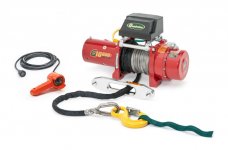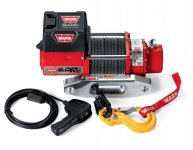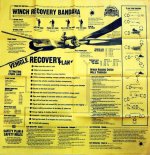All completely legitimate questions.
Newb question time!
How many pounds pull is a bad spot? Can I (with some effort) find myself in a situation which maxes a 12k lb 2-1 pull? Any idea roughly how much force Evo1 to the mirrors in mud would be?
The scenario with EVO1 on Drummond Island during the 2012 JKX is definitely considered a VERY HARD pull, and to be honest I didn't think we would get the jeep through the whole obstacle moving forward. I was wanting to pull Mel out backwards in his own tracks since they had not filled in :icon_crazy: As for how much force is holding the jeep in its place? Well that is hard to quantify, but I would bet it was double the weight of EVO1's 6000lbs since the initial single line pull we tried pulled the tree we were anchored to out of the ground. The jeep finally moved slowly forward when we attached the pulley.
For me it would be weight savings, but I'm sure many would consider the cost. Personally I'd be shopping for a solidly designed but lighter weight unit... Unless lots of pulls are above 10k pounds, then that wouldn't make much sense.
In the big picture of saving weight, this is an age old debate on how, where and when to try and drop pounds to increase mileage and its not something I personally get so fixated on that I ever lose sleep over. My jeep is big, its armored, it carries me and my load of stuff, and it gets combined city/hwy/trail mileage of 12mpg. I have accepted this. However saving weight is easy to do when most of your driving is around town= leave tools, hi-lift jack, spare tires (I never leave a spare behind) spare parts, supplies, roof racks, full fuel cans, etc all at home in the garage. Too many offroaders like to haul all there crap everywhere, all the time. Why, I'm not sure but if you want to prove to the world you are a serious, hardcore 4x4 dirt eating real man.....just put stickers all over your rig, they are lighter and say "look at me, I'm a badass" just as much as a full pioneer tool kit bolted to a roof rack (which is the second most effective wind brake next to a parachute). On the trail however, deciding what to absolutely take along and what you can do without is a struggle for some newer off roaders. It's something that only experience can teach. I'm pretty sure guys like Wayoflife and the other senior experienced wheelers (do not gauge this by forum post count either) are like me and have an almost identical load out for each and every trip. The only difference being the season and temperature changing what kind of clothing, sleeping and other comfort items I take along. But tools and offroad kit always remain the same and that's because I have learned what I need to cover down on almost every scenario. Another thing to consider is that any true effort to gain real weight savings on your jeep, is also going to have real weight reduction in another area.....your bank account :doh: buying high end, lighter weight, yet real quality parts is going to cost a bunch. I chose to basically lighten my jeep in a more permanent, and definitely noticeable, manner by getting rid of my full doors and hard top by running a Trek Top NX and Rugged Ridge plastic half doors. This helped to drop well over 400lbs of sprung weight. To me, saving 40-50lbs by choosing a tiny winch, which has a very narrow scope of use- the race course, is not worth getting anxious over. Another thing is that my winch of choice is a Warn PowerPlant, yes it's about 100lbs (probably less because I run synthetic line), but I also don't have to carry another compressor for on board air. The light weight competition winch is going to force you to have to carry another source for on board air, so you are gaining weight back that you thought you were saving.
Again, I'm a total newb, but I would have thought the number of times you just need a small push from a further anchor outweighs the bigger closer pulls. Does your experience say the opposite? (Assuming I'm not a huge fan of mud).
Yes, many times all you need is just a slight tug to overcome an obstacle. In fact, Wayolife and Carson Cindy has captured this on film when we ran Florence Junction back in May (?) of 2012. Check out the waterfall where I hang off EVO1's stinger and bounce enough traction onto the tires to climb over the 90 degree edge, then Mel returns the favor to literally hand pull my winch line and get EVOJEEP over the same waterfall. In fact Moby and the Powerline Patrol only needed human strength to clear it too!
There is no definite rule of how much effort you will need during recoveries. The words 'never' and 'always' do not apply to offroading :brows:
Any idea what the typical distance a vehicle would travel under winch? Inconvenient, but technically I'd only need double that distance (plus a few wraps) on the actual spool, right?
Man, if I knew this answer I would open fortune telling business

Each incident will determine this distance and hopefully you have an anchor point that is suitably close, at the perfect angle pointing at the winch and more than sturdy enough to safely recover your vehicle......but the words 'never' and 'always' come to mind.





